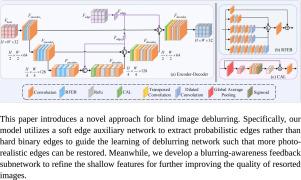基于软边缘感知和空间注意反馈的盲图像去模糊深度网络
IF 3.5
3区 计算机科学
Q2 COMPUTER SCIENCE, ARTIFICIAL INTELLIGENCE
引用次数: 0
摘要
当使用相机捕捉自然场景中的运动物体时,由于相机的抖动和物体的位移,所获得的图像会有不同程度的下降,这就是运动模糊。此外,自然场景的复杂性使图像运动去模糊更具挑战性。目前,基于深度学习的盲运动去模糊方法存在两个关键问题:(1)如何恢复具有精细纹理的清晰图像;(2)如何提高模型的泛化能力。在本文中,我们提出了软边缘感知和空间注意反馈深度网络(SASFNet)来恢复锐利图像。首先,我们使用软边缘辅助机制恢复具有精细纹理的图像。该机制利用软边缘提取网络从模糊图像中映射精细边缘信息,辅助模型恢复高质量的清晰图像。其次,为了模型的推广,我们提出了带关注的反馈机制。与课程学习类似,反馈机制模仿人类的学习过程,由易到难学习还原清晰的图像,不仅可以细化还原的特征,还可以带来更好的泛化。为了评估模型,我们使用GoPro数据集进行模型训练和有效性测试,并使用Realblur数据集测试模型的泛化性。实验表明,我们提出的SASFNet不仅可以恢复更符合人类感知的清晰图像,而且具有良好的泛化性。本文章由计算机程序翻译,如有差异,请以英文原文为准。

SASFNet: Soft-edge awareness and spatial-attention feedback deep network for blind image deblurring
When a camera is used to capture moving objects in natural scenes, the obtained images will be degraded to varying degrees due to camera shaking and object displacement, which is called motion blurring. Moreover, the complexity of natural scenes makes the image motion deblurring more challenging. Now, there are two crucial problems in Deep Learning-based methods for blind motion deblurring: (1) how to restore sharp images with fine textures, and (2) how to improve the generalization of the model. In this paper, we propose Soft-edge Awareness and Spatial-attention Feedback deep Network (SASFNet) to restore sharp images. First, we restore images with fine textures using a soft-edge assist mechanism. This mechanism uses the soft edge extraction network to map the fine edge information from the blurred image to assist the model to restore the high-quality clear image. Second, for the generalization of the model, we propose feedback mechanism with attention. Similar to course learning, feedback mechanism imitates the human learning process, learning from easy to difficult to restore sharp images, which not only refines the restored features, but also brings better generalization. To evaluate the model, we use the GoPro dataset for model training and validity testing, and the Realblur dataset to test the generalization of the model. Experiments show that our proposed SASFNet can not only restore sharp images that are more in line with human perception, but also has good generalization.
求助全文
通过发布文献求助,成功后即可免费获取论文全文。
去求助
来源期刊

Computer Vision and Image Understanding
工程技术-工程:电子与电气
CiteScore
7.80
自引率
4.40%
发文量
112
审稿时长
79 days
期刊介绍:
The central focus of this journal is the computer analysis of pictorial information. Computer Vision and Image Understanding publishes papers covering all aspects of image analysis from the low-level, iconic processes of early vision to the high-level, symbolic processes of recognition and interpretation. A wide range of topics in the image understanding area is covered, including papers offering insights that differ from predominant views.
Research Areas Include:
• Theory
• Early vision
• Data structures and representations
• Shape
• Range
• Motion
• Matching and recognition
• Architecture and languages
• Vision systems
 求助内容:
求助内容: 应助结果提醒方式:
应助结果提醒方式:


